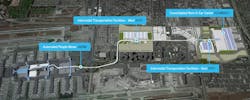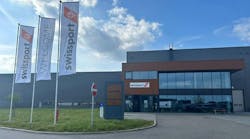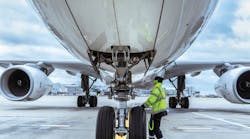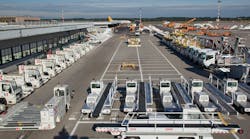Automated people movers have been in use in various forms for nearly a century. One of the first automated systems for human transportation was the screw-driven Never-Stop Railway constructed for the British Empire Exhibition at Wembley, London in 1924. Its 88 unmanned carriages moved on a continuous double track along the northern and eastern sides of the exhibition, with reversing loops at either end. The speed could be increased or slowed, depending on operational needs. The system operated reliably during the two years of the exhibition, after which it was dismantled.
Today, many automated people mover systems are being effectively utilized in various global urban transport environments, including at amusement parks, exhibition areas, shopping complexes, medical centers, and increasingly more airports.
APMs offer solutions
With the continued growth of air travel and swelling congestion, airports are looking for innovative transportation solutions to increase the speed and frequency of conveying passengers in and around airports to make the entire travel experience more efficient and pleasant.
As airports continue to undertake major modernization and infrastructure improvements to keep pace with growing passenger demand, they are increasingly considering utilizing automated people movers that can provide numerous mobility benefits for airports and their travelers.
Automated and driverless, people movers can carry up to 100 passengers in vehicles with multiple cars, offer frequent and point-to-point service not only to central terminal areas, but to and from intermodal transit facilities, and in some cases, even to metropolitan city centers. Convenient seamless transit options are further enhanced when automated people movers (APMs) can connect to light rail, bus and other public transportation systems.
Using APMs can relieve traffic congestion in the immediate airport vicinity, as well as alleviate traffic bottlenecks around passenger terminals. This transport technology can offer solutions to existing transit deficits and capacity issues, as well as associated air pollution, to significantly improve the transit experience for all travelers.
More recently, APM systems are being designed to connect airport terminals with landside facilities such as parking, car rental services, regional transportation services, hotels and other related employment and activity centers.
With airports about the size of small cities, passenger conveyance to and through the airport terminals and gates can often feel like running in a marathon. APMs can enable greater numbers of passengers to move more quickly and comfortably over longer distances, when walking or buses are not feasible. This helps passengers arrive at their aircraft gates faster and with less stress, especially those traveling at large airline hub operations.
APMs on the rise
Globally, airports have embraced this transport technology and implemented it as part of their master plans. At last count, there are 51 airports with automated people mover systems around the world. Nearly half (24) of those are in North America.
Several new APM systems are planned, including Los Angeles International Airport’s 2.25-mile Automated People Mover that will connect three on-airport stations to Metro Rail and transit services; a Consolidated Rent-A-Car center; two Intermodal Transportation Facilities for additional parking, ground transportation services, and meeter-greeter activities; and roadway improvements.
The automated people mover is part of the $5.5-billion Landside Access Modernization Program that will offer airport guests convenient and reliable choices to access the airport. Scheduled for completion by 2023, the improvements will reduce surrounding congestion and make LAX a world-class facility well in advance of the 2028 LA Olympics Games.
Elevating passenger satisfaction
It’s interesting to note that APMs likely play a significant role when it comes to airport customer satisfaction, based on results from the Skytrax World’s Best Airport Awards, a global benchmark of airport excellence. The 2017 Top 10 Best Airports include eight airports that have operational APMs. For the fifth year in a row, Singapore Changi Airport, known for excellence, innovation and its Skytrain, has claimed the world’s best title.
The Changi Airport Skytrain connects Terminals 1, 2 and 3 at Changi Airport. It was the first driverless and automated system in Asia. With the opening of the Changi Airport underground Mass Rapid Transit Station in 2002, the Skytrain connects passengers at Terminal 1 to the MRT station entrances located at Terminals 2 and 3. The free inter-terminal journey takes approximately four minutes to provide an efficient transport network. Changi undoubtedly deserves to be recognized for its ongoing commitment to the passenger experience.
Seamless intermodal solutions
In the United States, San Francisco International Airport’s intermodal solution is a classic example of seamless connectivity between the airport and the local metropolitan area. The airport’s automated people mover–AirTrain–links directly with the Bay Area Rapid Transit System (BART), which is a heavy rail line that serves many municipalities in the San Francisco Bay Area. Passengers can travel more conveniently between their homes and the airport, leaving their cars at home.
The HNTB-designed BART to San Francisco International Airport Extension and Stations project was a $500 million six-mile extension of underground subway, one mile of at-grade trackway and one mile of aerial bridge structure. The extension provides a direct train-to-plane connection that has become the No. 1 choice of air travelers taking public transportation to San Francisco International Airport.
Function and design
APM projects require extensive planning and evaluation to ensure they meet the goals and objectives of individual airports. In addition to planning a system and selecting the type of APM, there is also the need to incorporate design elements that can complement the airport facility and its surroundings and showcase the unique attributes of the airport’s locale.
Design management includes the overall responsibility for both engineering and design development, not only to meet the operational needs of the system but to ensure its constructability. An award-winning APM design encompasses many elements – economy, durability, aesthetics, etc., but ultimately the result is concerned with delivering on the program objective of transforming the airport, making it more accessible and enhancing the passenger experience.
This is accomplished by a rigorous design management process that encompasses design leadership, innovation, implementation of proven best practices and collaboration that will result in a transformative solution to each airport’s challenges. It requires a talented, coordinated, and well-organized design team that clearly understands the client’s requirements and their vision for the airport’s APM.
Experience counts
For airports embarking on major infrastructure improvements incorporating APMs, selecting the right team is fundamental to the future success of the project. Success driven teams bring specific and relevant technical expertise; familiarity with the airport, city and other local stakeholders; innovation and creativity; project coordination and quality control; and communication skills. These qualities ensure the project can be delivered on time and on budget, and equally importantly, meet the goals and objectives of the client.
Firms that have a track record of delivering successful complex transit projects bring distinct advantages to airport clients. HNTB’s work on airport automated people movers includes the Tampa International Airport Master Plan, with recommendation for a $4 billion modernization and expansion including new consolidated rental car facility linked to the main terminal via an automated people mover; and Hartsfield-Jackson Atlanta International Airport’s South Concourse Development, which includes plans for new midfield concourses served by a second secure APM system in order to serve 153 million annual passengers; among numerous others.
More travelers – More APMs
According to the International Air Transport Association, approximately 7.8 billion passengers are expected to travel in 2036, a near doubling of the 4 billion air travelers projected to fly this year. The prediction is based on a 3.6% average Compound Annual Growth Rate noted in the latest update to the association’s 20-Year Air Passenger Forecast.
As growth continues, airports must prepare today if they expect to be able to handle ever increasing passengers in the coming decades. Automated people mover systems will become progressively more essential to provide multi modal accessibility to efficiently and conveniently transport passengers, not only in and around airports, but closer to their final destinations. Innovation and modernization will be key drivers in the race to keep pace with growth in air travel. It’s time to get on board with people movers.
Peter Aarons is West Division aviation director and associate vice president for HNTB Corporation. He has more than 25 years of experience in planning, development, design, program and project management, and construction for airports. Contact





